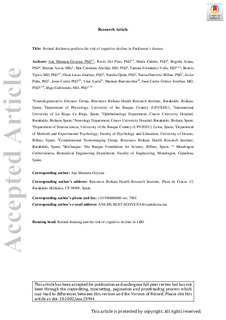| dc.rights.license | Attribution-NonCommercial-NoDerivatives 4.0 International | * |
| dc.contributor.author | Ayala, Unai | |
| dc.contributor.author | Barrenechea, Maitane | |
| dc.contributor.other | Murueta-Goyena, Ane | |
| dc.contributor.other | Pino, Rocío Del | |
| dc.contributor.other | Galdós, Marta | |
| dc.contributor.other | Arana, Begoña | |
| dc.contributor.other | Carmona-Abellán, Mar | |
| dc.contributor.other | Fernández-Valle, Tamara | |
| dc.contributor.other | Tijero, Beatriz | |
| dc.contributor.other | Lucas-Jiménez, Olaia | |
| dc.contributor.other | Ojeda, Natalia | |
| dc.contributor.other | Ibarretxe-Bilbao, Naroa | |
| dc.contributor.other | Peña, Javier | |
| dc.contributor.other | Cortes, Jesus | |
| dc.contributor.other | Gómez-Esteban, Juan Carlos | |
| dc.contributor.other | Gabilondo Cuellar, Iñigo | |
| dc.date.accessioned | 2020-11-02T17:03:08Z | |
| dc.date.available | 2020-11-02T17:03:08Z | |
| dc.date.issued | 2021 | |
| dc.identifier.issn | 1531-8249 | en |
| dc.identifier.other | https://katalogoa.mondragon.edu/janium-bin/janium_login_opac.pl?find&ficha_no=161555 | en |
| dc.identifier.uri | https://hdl.handle.net/20.500.11984/1880 | |
| dc.description.abstract | Objective: To analyze longitudinal changes of retinal thickness and their predictive value as biomarkers of disease progression in idiopathic Parkinson’s disease (iPD).
Methods: Patients with Lewy body diseases (LBDs) were enrolled and prospectively evaluated at 3 years, including patients with iPD (n=42), dementia with Lewy bodies (DLB, n=4), E46K-SNCA mutation carriers (n=4) and controls (n=17). All participants underwent Spectralis retinal optical coherence tomography and Montreal Cognitive Assessment (MoCA), and Unified Parkinson’s Disease Rating Scale (UPDRS) score was obtained in patients. Macular ganglion-inner plexiform layer complex (GCIPL) and peripapillary retinal nerve fiber layer (pRNFL) thickness reduction rates were estimated with linear mixed models. Risk ratios were calculated to evaluate the association between baseline GCIPL and pRNFL thickness and the risk of subsequent cognitive and motor worsening, using clinically meaningful cut-offs.
Results: GCIPL thickness in the parafoveal region (1- to 3-mm ring) presented the largest reduction rate. The annualized atrophy rate was 0.63 µm in iPD patients and 0.23 µm in controls (p<0.0001). iPD patients with lower parafoveal GCIPL and pRNFL thickness at baseline presented an increased risk of cognitive decline at 3 years (RR 3.49, 95% CI 1.10 – 11.1, p=0.03 and RR 3.28, 95% CI 1.03 – 10.45, p=0.045, respectively). We did not identify significant associations between retinal thickness and motor deterioration.
Interpretation: Our results provide evidence of the potential use of OCT-measured parafoveal GCIPL thickness to monitor neurodegeneration and to predict the risk of cognitive worsening over time in iPD. | es |
| dc.description.sponsorship | Michael J. Fox Foundation | es |
| dc.description.sponsorship | Gobierno de España | es |
| dc.description.sponsorship | Gobierno de España | es |
| dc.description.sponsorship | Gobierno de España | es |
| dc.description.sponsorship | Gobierno Vasco | es |
| dc.description.sponsorship | Gobierno Vasco | es |
| dc.language.iso | eng | en |
| dc.publisher | Wiley | en |
| dc.rights | © The Authors | en |
| dc.rights.uri | http://creativecommons.org/licenses/by-nc-nd/4.0/ | * |
| dc.subject | neurodegeneration | en |
| dc.subject | visual dysfunction | en |
| dc.subject | optical coherence tomography | en |
| dc.title | Retinal thickness predicts the risk of cognitive decline in Parkinson's disease | en |
| dcterms.accessRights | http://purl.org/coar/access_right/c_abf2 | en |
| dcterms.source | Annals of Neurology | en |
| local.contributor.group | Teoría de la señal y comunicaciones | es |
| local.description.peerreviewed | true | en |
| local.identifier.doi | https://doi.org/10.1002/ana.25944 | en |
| local.relation.projectID | RRIA 2014 (Rapid Response Innovation Awards) Program (Grant ID: 10189) | en |
| local.relation.projectID | GE/Instituto de Salud Carlos III/PI14-00679/ES/Estudio por neuroimagen de los portadores de la mutación E46K del gen de la alfa sinucleína como modelo de enfermedad por cuerpos de Lewy idiopática/ | en |
| local.relation.projectID | GE/Instituto de Salud Carlos III/PI16-00005/ES/Identificación de biomarcadores de la retina y la vía visual en formas genéticas de enfermedad de Parkinson como un modelo para enfermedad de Parkinson idiopática/ | en |
| local.relation.projectID | GE/Instituto de Salud Carlos III. Contratos Juan Rodés/JR15-00008/// | en |
| local.relation.projectID | GV/Ayudas a proyectos de investigación y desarrollo en salud 2016/2016111009/CAPV/Identificación de biomarcadores de la retina y la vía visual en formas genéticas de enfermedad de Parkinson como un modelo para enfermedad de Parkinson idiopática/ | en |
| local.relation.projectID | GV/Ayudas a proyectos de investigación y desarrollo en salud 2020/2020333033/CAPV/Aplicación clínica de la inteligencia artificial sobre imágenes de OCT de retina para la clasificación precoz y monitorización de pacientes con enfermedad de Parkinson/ | en |
| local.rights.publicationfee | APC | en |
| local.rights.publicationfeeamount | 2500 EUR | en |
| local.contributor.otherinstitution | https://ror.org/0061s4v88 | es |
| local.contributor.otherinstitution | https://ror.org/000xsnr85 | es |
| local.contributor.otherinstitution | https://ror.org/029gnnp81 | es |
| local.contributor.otherinstitution | https://ror.org/03nzegx43 | es |
| local.contributor.otherinstitution | https://ror.org/00ne6sr39 | es |
| local.contributor.otherinstitution | https://ror.org/01cc3fy72 | es |
| local.source.details | First published: 24 October 2020 | en |
| oaire.format.mimetype | application/pdf | |
| oaire.file | $DSPACE\assetstore | |
| oaire.resourceType | http://purl.org/coar/resource_type/c_6501 | en |
| oaire.version | http://purl.org/coar/version/c_ab4af688f83e57aa | en |








